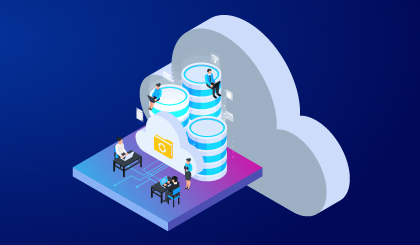The way businesses utilize and manage their data has been changed by the cloud. Today’s organizations rely heavily on data, and effective data management is essential to fostering innovation and maintaining competitiveness. Strong data management methods must be designed and implemented by cloud architect, the digital transformation architects. We will examine the best practices for data management in the cloud in this article, giving cloud architects crucial knowledge and recommendations for maximizing the potential of data in a cloud context.
Table of Contents
The Importance of Cloud Data Management
Data is a strategic asset in the modern digital age; it’s more than just information. Utilizing data effectively can provide businesses with a competitive edge, enabling data-driven decision-making and stimulating innovation. How data is stored, processed, and used within an organization is fundamentally shaped by cloud architecture.
Choosing the appropriate data storage options, such as databases, data lakes, and object storage, as well as where and how data will be stored, are important aspects of data management in cloud storage.
- Processing: Creating procedures for the transformation, analysis, and visualization of data.
- Security: Putting in place strong security measures to guard against hacks and illegal access.
- Data management solutions must be scalable as data volumes increase.
- Accessibility: Enabling authorized users to quickly and securely access data from any place.
Best Practices for Cloud Data Management
Effective cloud data management requires a multifaceted approach. Data security, performance, scalability, and cost minimization are a few of the considerations that cloud architects must take into account. The following best practices can help cloud architects manage data effectively.
1. Data Governance
- Developing Data Governance Policies to assure data quality, compliance, and security, implementing data governance policies and frameworks. Establish the duties and roles involved in data management.
- Data classification: Arrange data according to its significance and sensitivity. To protect sensitive data, implement access rules and encryption based on data classifications.
- Compliance and Regulations: Be aware of and abide by your organization’s specific data protection laws, industry standards, and best practices. The GDPR, HIPAA, and other industry-specific rules could be examples of this.
2. Data Security Encryption:
- Use encryption to prevent unauthorized access to data both in transit and at rest. Employ key management procedures and encryption protocols that are industry standard.
- Access Control: Put tight access control measures into place. Only allow authorized users and programs access to data. RBAC, or role-based access control, is a useful method for controlling access permissions.
- Implement thorough audits and monitoring of data access and modifications. Security monitoring tools and services are frequently provided by cloud providers.
3. Data Warehousing and Storage
- Data Storage Alternatives Select the storage options that are most suited for the various data kinds. Relational databases may be appropriate for structured data, whereas object storage or data lakes may be necessary for unstructured data.
- Scalability: As data volumes increase, make sure your data storage options can keep up. When more storage is required, auto-scaling options are available from cloud providers.
- Implement data warehousing systems for analytics on structured data. High performance and scalability are two benefits of cloud-based data warehousing platforms like Amazon Redshift and Google BigQuery.
4. Disaster Recovery and Data Backup
- Implement regular data backups to protect against the loss of information due to hardware malfunctions, unintentional deletion, or cyberattacks.
- Data recovery processes should be included in complete disaster recovery plans that are created in the event that a system fails, a natural disaster strikes or another catastrophic event occurs.
- Redundancy: To assure data availability even in the face of unforeseen catastrophes, use cloud storage redundancy options like multi-region replication.
5. Data Processing
- Take advantage of serverless computing services to process data. Without the requirement for server setup and management, serverless technologies like AWS Lambda and Azure Functions may perform data processing operations on demand.
- Big Data Tools: For extensive data processing and analytics, use big data tools and frameworks like Hadoop, Spark, and Flink. Managed big data services are provided by cloud providers to make deployment and management easier.
- Design data pipelines for ingesting, transforming, and delivering data. The development of data pipelines can be facilitated by programs like Apache NiFi and AWS Glue.
6. Cost Optimization Usage Monitoring:
- Constantly keep an eye on how much data is stored and processed to find ways to cut costs
- Implement data archiving and lifecycle policies to have less frequently viewed data automatically moved to lower-cost storage tiers.
- Right-Sizing Resources: Adjust cloud storage and computing resources to the precise requirements of data processing workloads. Overprovisioning and overspending are avoided as a result.
7. Data Performance and Accessibility:
- Use content delivery networks (CDNs) to quickly distribute data to people throughout the world. From cloud storage, CDNs deliver and cache content to edge locations.
- Data compression and chunked transfer encoding are two examples of content acceleration techniques that can be used to improve data delivery.
- Caching Techniques: Use caching techniques to increase data access speed and decrease the burden on data storage.
8. Metadata Management Cataloging Metadata:
- Create a catalog of metadata to offer details about data assets, such as definitions, sources, and history.
- Data Discovery: Make it possible for users to locate data assets quickly and efficiently. Implement metadata search tools and data discovery technologies.
- Data Lineage: Follow data lineage to learn about the beginnings and changes made to data over the course of its life.
9. Multi-Cloud and Hybrid Data Management:
- Hybrid Cloud: Take into account hybrid cloud solutions that link cloud environments and on-premises data centers. Ensure smooth data management and integration between these two domains.
- Design data management architectures that can span many cloud providers using multi-cloud strategies. Utilize the compatibility and interoperability of many cloud services.
- Plan for data portability and migration between various cloud service providers to make sure that data is still accessible and usable when switching between services.
10. Education and skill building:
- Encourage data management teams and cloud architects to continually learn about the newest cloud technologies, data management best practices, and market trends.
- Invest in the training and certification programs that cloud service providers provide. Cloud solutions may be implemented and managed more successfully by certified personnel.
- Promote cross-functional cooperation between the development, security, and data management teams to ensure a comprehensive approach to data management.
Conclusion
Data management in the cloud is a multifaceted undertaking that calls for meticulous planning, strong security protocols, and effective use of cloud resources. As the forerunners of digital transformation, cloud architects are crucial in developing and putting into practice data management strategies that maximize the value of data while protecting it from dangers. Cloud architects can create robust, scalable, and effective data management solutions by embracing best practices in data governance, security, storage, processing, and cost optimization. These solutions not only make it possible for businesses to gain insightful knowledge from their data but also make sure that data is safe, secure, and consistent with industry standards.
Cloud architects are the architects of the future in a time when data is essential to digital success, empowering businesses to harness the power of data to spur innovation, competitiveness, and growth. The full potential of data assets can be unlocked by enterprises with the help of cloud architects who have a solid foundation in data management best practices.












